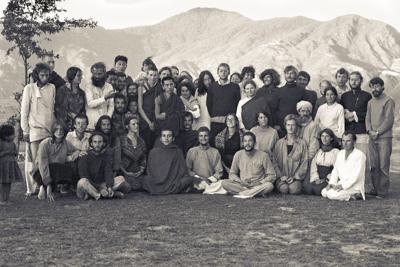Dear Friends,
Thank you, Rinpoche, for changing my life.
That’s what I said to Lama Zopa Rinpoche just after this photo was taken at the top of the Kopan hill after the third Kopan meditation course, my first, in November, 1972. Rinpoche laughed and grabbed my hand to walk back down to the gompa holding it, but I shyly pulled away. Still regret that!
I’ve told the story of how I got to Kopan before and why I became a monk a year or so later. In the preface to Lama Yeshe’s Becoming Vajrasattva, which I edited, I briefly mentioned how I met Lama. In that piece I wrote, “All of us in the FPMT give continual thanks to Lama Zopa Rinpoche, our shining beacon of wisdom and compassion and a living example of enlightened realizations. When Lama Yeshe passed away, Rinpoche seamlessly maintained the development of the FPMT until it now comprises more than one hundred centers and study groups in thirty-one countries around the world, while continuing to lead an ever-growing number of international disciples spiritually, both by his incomparable demeanor and by his profound teachings.” (Currently there are 141 centers, projects and services in thirty-four countries worldwide.)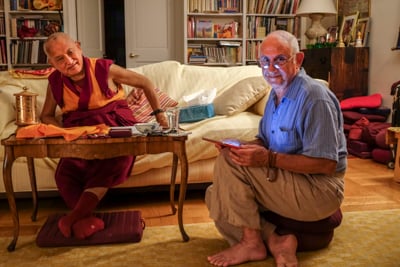 Now that beacon no longer shines as it once did, but, as the Buddha told Ananda as he was passing away and his disciples were lamenting their loss of a guide, “It may be, Ananda, that some of you will say, ‘Without the Buddha, the Sublime Teacher, there is no teacher for us.’ No, Ananda, you should not think in this way. Whatever doctrine and discipline taught and made known by me will be your teacher when I am gone.”
Now that beacon no longer shines as it once did, but, as the Buddha told Ananda as he was passing away and his disciples were lamenting their loss of a guide, “It may be, Ananda, that some of you will say, ‘Without the Buddha, the Sublime Teacher, there is no teacher for us.’ No, Ananda, you should not think in this way. Whatever doctrine and discipline taught and made known by me will be your teacher when I am gone.”
And so it is with us now. Unlike the Buddha’s teachings at the time, Rinpoche’s vast collection of instruction over the past fifty years remains immediately accessible as audio, transcripts, edited teachings and video: far more than any of us can listen to, read and watch, let alone practice in what is left of our own lifetimes.
As Rinpoche often said, whenever we hear that someone has passed away we should immediately bring to mind our own impending death and realize: so much to do, so little time. And now, this is precisely Rinpoche’s last advice to us. And as he also said, “Do more, not less!”
Letting Go: Reflections on the Parinirvana of Lama Zopa Rinpoche
This month we offer a talk Tenzin Ösel Hita gave at Kopan Monastery on April 18, 2023, shortly after the parinirvana of Lama Zopa Rinpoche. Ösel shares his feelings and memories about Rinpoche and offers advice on how to recognize and deal with our attachment to the guru. Filmed by Bill Kane with video and audio editing by Megan Evart.
Visit and subscribe to the LYWA YouTube channel to view more videos freely available from our archive. See also the FPMT YouTube channel for many more videos of Lama Zopa Rinpoche’s teachings.
ON THE LYWA PODCAST: THIS PRECIOUS HUMAN REBIRTH
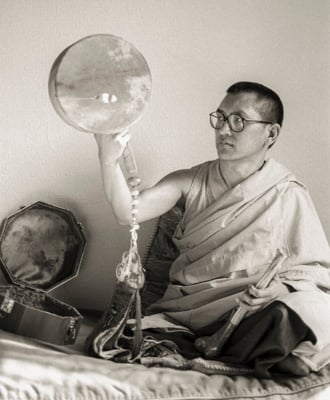 It is amazing how even within a minute, even in each second, eating, walking, sitting, sleeping, wow, what you can do with this precious human body by understanding and practicing the Dharma.
It is amazing how even within a minute, even in each second, eating, walking, sitting, sleeping, wow, what you can do with this precious human body by understanding and practicing the Dharma.
-Lama Zopa Rinpoche
This month on the LYWA podcast, Lama Zopa Rinpoche celebrates our perfect human rebirth and encourages us to bring every single moment of our life onto the path to enlightenment. Rinpoche gave these teachings prior to a chöd initiation at Maitripa College, Portland, Oregon, in June 2009. You can read along with the transcript on our website.
The LYWA podcast contains hundreds of hours of audio, each with links to the accompanying lightly edited transcripts. See the LYWA podcast page to search or browse the entire collection by topic or date, and for easy instructions on how to subscribe.
WHAT'S NEW ON OUR WEBSITE
This month we have posted a revised Twenty-One Taras text, which includes the Praises, a commentary, a critique of the various translations, and images of the Twenty-One Taras according to both the Suryagupta and the Nagarjuna-Atisha lineage. This publication also includes many beautiful color images depicting each aspect of Tara. Compiled and edited by Hermes Brandt in April 2023. The text can be found on our EEC1 page.
Now included in LYWA's free book offerings is Lama Zopa Rinpoche's book The Perfect Human Rebirth: Freedom and Richness on the Path to Enlightenment. Edited by Gordon McDougall. In this book, Rinpoche explains in the greatest possible detail just how precious this opportunity is and why we should not waste a moment of it. You can order the print version, free with shipping, on our website or download the PDF here.
This month we have posted several short excerpts from Kopan Course No. 38 for you to enjoy. Lama Zopa Rinpoche teaches on buddha nature, our potential to become a buddha, and tells the story of Milarepa, an inspiring example of guru devotion. Rinpoche explains the benefits of offering to the Buddha and advises the root of samsara according to the four philosophical schools.
 Every month we share new advices for Lama Zopa Rinpoche’s Online Advice Book, adding more than 100 new entries every year on a variety of topics. More precious than ever, there are now more than 2,200 of Rinpoche’s advices online.
Every month we share new advices for Lama Zopa Rinpoche’s Online Advice Book, adding more than 100 new entries every year on a variety of topics. More precious than ever, there are now more than 2,200 of Rinpoche’s advices online.
- Your Sister Is Most Kind: A student was experiencing many obstacles and disharmony within their family. In this extensive advice, Rinpoche emphasizes the importance of generating bodhicitta, the mind of enlightenment.
- Confession and Purification with Thirty-five Buddhas Practice: Rinpoche gave this advice to a student who had confessed to criticizing Rinpoche and not following his advice.
- The Kindness of the Guru is Like the Limitless Sky: This message of thanks was given to all the people who had prayed for His Holiness the Dalai Lama and Tibet, as requested by Rinpoche in June 2018.
- Overwhelmed by Attachment: Rinpoche sent this long letter to a student who felt strong attachment for a former partner. Rinpoche advised emptiness meditation and explained that long-lasting relationships are based on unconditional love and compassion, not samsaric desire.
You can always find a list of all the newly posted advices from Lama Zopa Rinpoche on our website.
Tributes and Updates for Lama Zopa Rinpoche
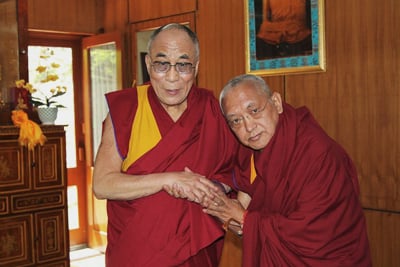 Please note that on behalf of the entire FPMT organization a long life puja will be offered to His Holiness the Dalai Lama on May 24, 2023 at Namgyal Monastery, Dharamsala, India. This fulfills one of Lama Zopa Rinpoche’s holy wishes. You can find out more information here.
Please note that on behalf of the entire FPMT organization a long life puja will be offered to His Holiness the Dalai Lama on May 24, 2023 at Namgyal Monastery, Dharamsala, India. This fulfills one of Lama Zopa Rinpoche’s holy wishes. You can find out more information here.
Also on May 31, 2023, a Heruka Lama Chöpa with Tsog will be offered at Kopan Monastery to recognize the 49th day since Lama Zopa Rinpoche’s passing. All are welcome to join the livestream of this special puja. You can join the livestream here.
In order to stay updated, please visit our tributes and important updates page, in addition to keeping up with all the news, updates and resources on the FPMT website. You can also find on our tributes page the prayers for Rinpoche's swift return, reproduced by Piero Sirianni as a beautiful PDF file. You can download the PDF here, for viewing on your mobile device or computer.
Big love,

Nick Ribush
Director
THIS MONTH'S TEACHING: THE GURU IS ALL THE BUDDHAS
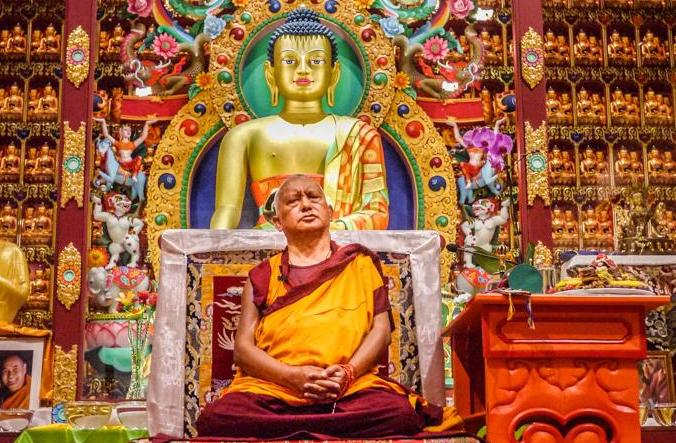 The transcendental wisdom of nondual bliss and voidness, the dharmakaya of all the buddhas’ holy minds, that is the absolute guru. Guru has two senses: the conventional guru and the absolute guru. In Tibetan it’s kun dzob lama and don dam lama. We have to think of the very heart, the essence, don dam lama, which is the absolute guru. We have to know what that is. Once we know that, that’s the main focus. What’s the real meaning of “guru”? The very heart of that, what it really means, from our side that is what we should realize.
The transcendental wisdom of nondual bliss and voidness, the dharmakaya of all the buddhas’ holy minds, that is the absolute guru. Guru has two senses: the conventional guru and the absolute guru. In Tibetan it’s kun dzob lama and don dam lama. We have to think of the very heart, the essence, don dam lama, which is the absolute guru. We have to know what that is. Once we know that, that’s the main focus. What’s the real meaning of “guru”? The very heart of that, what it really means, from our side that is what we should realize.
The dharmakaya is that which is eternal, with no beginning and no end; it pervades all phenomena. As I mentioned the other day, the Buddha’s holy mind pervades all phenomena, not just seeing all phenomena from a distance but pervading it, covering all phenomena. The real proof of that comes from the highest tantra. The Buddha’s holy body and mind is not like our body, caused by karma and delusion, with bones and flesh and all that. It’s not like that. There is the gross body, the subtle body and the extremely subtle body. Like that, the absolute guru has no beginning and no end and pervades all phenomena. As a highly attained Tibetan lama, Khedrub Sangye Yeshe, mentioned “Before the guru, not even what is called ‘Buddha’ exists.” No buddha existed before the guru, not even the name “buddha.”
If we don’t come to know what the absolute guru is, there’s no way to understand that meaning, and also the refuge prayer, La ma sang gyä la ma chhö [Taking Refuge in the Gurus], there’s no way to understand that meaning. The door to all these is the guru. The guru is Buddha, Dharma and Sangha, and all the doors are the guru. That means the guru is the one we receive all our happiness from: all the past happiness from beginningless rebirths, all the present happiness and all the future happiness, including the ultimate happiness, liberation from samsara, and full enlightenment. The guru is the one we receive all the collections of goodness from. It comes from the source, the guru.
So, all the buddhas come from the absolute guru. All the past, present and future buddhas come from the absolute guru. This is the way to actually understand what the absolute guru is. The guru is the one who manifests. One way to understand is that the guru manifests into all the various aspects of the Buddha, taking all the various peaceful and wrathful aspects of the Buddha. There are four classes of the tantric deities in the nirmanakaya aspect—those thousands of buddhas, the Medicine Buddhas, the Thirty-five Buddhas and so on, all those buddhas.
In the same way, the Dharma, which is revealed from these different aspects of the buddhas, comes from the guru. You can see here very clearly where the Dharma comes from, and where the Sangha comes from. When we take refuge in the Buddha, Dharma and Sangha, they all come from the guru.
Most of us do not have pure karma so we cannot see the guru in the aspect of the deity, in the aspect of the Buddha. Since our karma is impure, our mind is impure, the only way the buddhas can communicate with us, the only way we can receive teachings and guidance from them is by manifesting in an ordinary form. There is no other way to guide us at all except manifesting in an ordinary form. What’s the definition of “ordinary form?”
By saying this, I’m not saying that I’m a buddha! You should not misunderstand that! The definition of “ordinary form” is having delusions, having suffering such as old age, sickness, death and rebirth. And then showing mistakes in the actions. That is what “ordinary form” means.
At the moment, until we have purified this impure karma, this impure mind, we have no other way for the pure aspect of the Buddha to directly guide us, to reveal teachings, to grant vows and initiations. The only way is for this ordinary form to guide us directly, to look after us and protect us from the sufferings of the lower realms and from the oceans of samsaric sufferings, the sufferings of the human and god realms. This ordinary form can save us from all this, liberating us from samsara. Its continuation has had no beginning but who ends our suffering in samsara? By revealing the four noble truths, the truth of suffering, the truth of the cause of suffering, the truth of the cessation of suffering and the truth of the path, the philosophical teachings, and the heart of the Buddhadharma, the lamrim, the stages of the path to enlightenment—in that way, this ordinary form brings us to enlightenment.
To be liberated, we need to actualize the path to liberation, which means those five paths to liberation and two things: the foundation clear trainings, which need the requirement of living in the pratimoksha vows to liberate us from the samsara, by living in the bodhisattva vows to bring us to full enlightenment and by living in the tantric vows to cause us to achieve enlightenment not just in one life but in a brief lifetime of degenerated time. In that way, we can liberate sentient beings from the oceans of samsaric suffering quickly and bring them to enlightenment quickly, whereas the other way would take a long time—many eons. Like that, the guru can grant the advice, the practice, can give commentaries and initiations that allow us to practice the path, to listen, to reflect, to meditate and to actualize the tantric path. Like this, the guru guides us to liberation and enlightenment.
It is very good to meditate like this when we do the guru yoga meditation. Maybe I’ll mention this first since I mentioned guru devotion, so those who are new can get some clear idea.
Excerpted from teachings given by Lama Zopa Rinpoche at the 38th Kopan Meditation Course, held at Kopan Monastery, Nepal, in December 2005. Lightly edited by Gordon McDougall.























